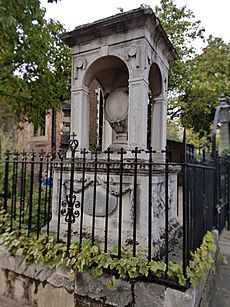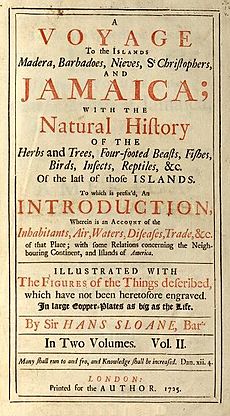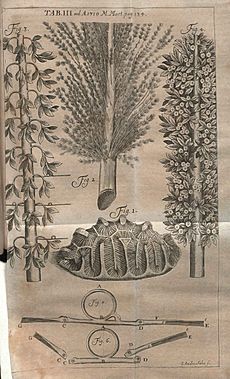Hans Sloane facts for kids
Quick facts for kids
Sir
Hans Sloane
|
|
|---|---|

Portrait by Stephen Slaughter
|
|
| 13th President of the Royal Society | |
| In office 1727–1741 |
|
| Preceded by | Isaac Newton |
| Succeeded by | Martin Folkes |
| President of the Royal College of Physicians | |
| In office 1719–1735 |
|
| Preceded by | John Bateman |
| Succeeded by | Thomas Pellett |
| Personal details | |
| Born | 16 April 1660 Killyleagh, Ireland |
| Died | 11 January 1753 (aged 92) London, England |
| Resting place | Chelsea Old Church |
| Nationality | British |
| Known for | Physician Philanthropist Entrepreneur Investor Chelsea Physic Garden British Museum Sloane Square Sloane's drinking chocolate |
| Spouse(s) | Elisabeth Sloane (née Langley) |
| Awards | Fellow of the Royal Society (1685) |
Sir Hans Sloane (born April 16, 1660 – died January 11, 1753) was an Irish doctor, scientist, and collector. He gathered an amazing 71,000 items! He later gave this huge collection to the British nation. This gift helped create the famous British Museum, the British Library, and the Natural History Museum, London.
Sloane became a member of the important Royal Society when he was just 24. In 1687, he traveled to the Caribbean and wrote detailed books about his discoveries years later. He was a well-known doctor, especially among rich families. He also became president of the Royal College of Physicians at age 27.
Many people credit him with inventing chocolate milk. However, he likely learned about adding milk to drinking chocolate while living in Jamaica. Today, many streets and places are named after him. These include Sloane Square in London, near where he lived, and Sir Hans Sloane Square in his hometown of Killyleagh, Northern Ireland.
Contents
Early Life and Family Background
Hans Sloane was born on April 16, 1660, in Killyleagh, a village in County Down, Ireland. He was the seventh and last child of Alexander Sloane. His father passed away when Hans was only six years old.
Alexander Sloane worked as a tax collector for County Down. Hans's mother, Sarah Hicks, was English. The Sloane family had moved to Ireland from Ayrshire, Scotland. They settled there under King James VI and I.
After his father's death, the Hamilton family helped care for Hans and his siblings. Hans spent a lot of time studying in the Killyleagh Castle library. Out of Alexander's sons, only Hans, William, and James lived to be adults. His older brother, James, later became a Member of Parliament.
As a young person, Sloane loved collecting natural objects and other interesting things. This hobby led him to study medicine in London. There, he learned about plants, medicines, surgery, and how to make medicines. His collecting skills were useful to famous scientists like John Ray and Robert Boyle.
After four years in London, he traveled through France. He spent time in Paris and Montpellier. He also earned his medical degree in 1683 at the University of Orange-Nassau. A famous doctor, Thomas Sydenham, hired Sloane as an assistant. Sydenham helped Sloane get important connections in the medical world. Sloane returned to London with many plants and other items. He sent the plants to John Ray for his book, History of Plants.
Caribbean Voyage and Chocolate Milk
Sloane joined the Royal Society in 1685. In 1687, he became a fellow of the College of Physicians. That same year, he sailed to Jamaica on the ship HMS Assistance. He went as the personal doctor to the new Governor of Jamaica, the 2nd Duke of Albemarle.
The Duke of Albemarle died in Jamaica the next year, in 1688. So, Sloane's trip lasted only 15 months. During his time in the Caribbean, Sloane visited several islands. He collected over 1,000 plant samples. He also gathered large amounts of cacao and Peruvian bark. He later used the bark to get quinine, a medicine for eye problems.
Sloane found about 800 new plant species. He listed them in Latin in his book, Catalogus Plantarum Quae in Insula Jamaica Sponte Proveniunt, published in 1696. His first writings about his trip appeared in the Philosophical Transactions of the Royal Society. In these, Sloane described Jamaican plants like the Pepper Tree and coffee-shrub. He also wrote about earthquakes that hit Lima and Jamaica.
Sloane married Elizabeth Langley Rose. She was a wealthy widow from Jamaica. Her family owned sugar plantations there. Sloane and Elizabeth had three daughters and one son. Only two daughters, Sarah and Elizabeth, lived past childhood.
After returning to Britain, Sloane earned money from his medical practice. He also had investments in London property. Elizabeth's inheritance added to their wealth. This allowed Sloane to build his huge collection of natural history items.
The Natural History Museum says Sloane invented drinking chocolate with milk. However, Jamaicans were already making a hot drink from cacao, milk, and cinnamon as early as 1494. Sloane found the local way of drinking cocoa mixed with water to be unpleasant. Many recipes for mixing chocolate with spices, eggs, sugar, and milk existed by the 1600s.
Sloane might have created his own recipe for chocolate with milk. But he was probably not the first to do so. By the 1750s, a grocer in London sold "Sir Hans Sloane's Milk Chocolate." He claimed it was a medicinal drink. Later, in the 1800s, the Cadbury Brothers sold tins of drinking chocolate. Their advertisements also mentioned Sloane's recipe.
A Doctor for High Society
Sloane opened his own medical practice in London in 1689. He became very popular among the upper classes. He built a large and profitable practice. He served as a doctor to three queens and kings: Queen Anne, George I, and George II.
Some people criticized Sloane during his lifetime. They called him a "virtuoso," meaning he collected things without fully understanding their scientific meaning. One critic said he was just interested in "knick-knacks." Another called him the "foremost toyman of his time." Even Sir Isaac Newton reportedly called Sloane "a villain and rascal."
Some believed his real success came from making friends with important people. They thought he was better at networking than at science. Even as a doctor, he wasn't always respected. People saw him mainly as someone who sold medicines and collected oddities. Sloane's only medical book was published when he was 85.
In 1716, Sloane was given the title of baronet. This made him the first doctor to receive a hereditary title. In 1719, he became president of the Royal College of Physicians. He held this position for 16 years. In 1722, he became the army's chief physician. In 1727, he became the first physician to King George II.
He was also secretary to the Royal Society from 1693. He edited its Philosophical Transactions for 20 years. In 1727, he took over from Sir Isaac Newton as president. He retired from the Society when he was 80 years old. Sloane's busy roles at the Royal Society left him little time for his own scientific research. This led to some of the criticism he received.
Sloane's true achievement at the Royal Society was connecting different worlds. He linked science with politics and high society. His time studying in France earlier in his career helped him. He became a go-between for British and French scientists. This helped share knowledge during the Age of Enlightenment. Famous visitors who came to see Sloane's collection included Voltaire, Benjamin Franklin, and Carl Linnaeus.
Sloane was also a member of science academies in France, Prussia, Saint Petersburg, Madrid, and Göttingen.
Helping Others Through Charity
Sloane was very charitable. He helped at Christ's Hospital from 1694 to 1730. He even donated his salary back to the institution. He also supported a special pharmacy at the Royal College of Physicians. This pharmacy provided inexpensive medicines. He also ran a free surgery every morning.
He was a founding governor of London's Foundling Hospital. This was the first place in the country to care for abandoned children. All children there had to get vaccinated against smallpox. Sloane was one of the doctors who promoted vaccination to prevent smallpox. He used it on his own family and encouraged the royal family to use it too.
The British Museum and Chelsea Physic Garden
In 1712, Sloane bought the manor of Chelsea in London. This land later became the Chelsea Physic Garden. Over his lifetime, Sloane collected more than 71,000 objects. These included books, manuscripts, drawings, coins, medals, and plant samples.
A big moment for his collection happened in 1702. He received the collection of William Courten, who had spent his life collecting. Sloane got it by agreeing to pay some of Courten's debts.
When Sloane retired in 1741, his library and collection were incredibly valuable. He moved them from Bloomsbury to his house in Chelsea. He had acquired many other large collections. These included items from famous collectors like William Courten, Cardinal Filippo Antonio Gualterio, and James Petiver.
Death and Lasting Impact

In his last year, Sir Hans Sloane suffered from a health problem that caused some paralysis. He passed away on January 11, 1753, at his home in Chelsea. He was buried on January 18 at Chelsea Old Church. His grave is shared with his wife, Elisabeth, who died in 1724.
When he died, Sloane gave his huge collection to the nation. This included his books, manuscripts, prints, drawings, plants, animals, medals, coins, and other interesting items. He asked Parliament to pay his family £20,000 for it. This was much less than the collection's true worth, which some estimated at over £80,000.
Parliament accepted his offer that same year. Sloane's collection, along with the royal library, became the foundation for the British Museum. A large part of it also formed the basis for the Natural History Museum. Sloane wanted his collection to be seen by anyone who wished to see it. However, the first people in charge of the museum believed that only scholars and the upper class should see it. They thought learning was a privilege only for the wealthy.
Sloane also gave the land of the Chelsea Physic Garden to the Society of Apothecaries. They had been renting it since 1673. A life-size statue of Sloane stands in the town square of Killyleagh, where he was born.
Places Named After Sloane
Many places in London are named after Sir Hans Sloane. These include Sloane Square, Sloane Street, Sloane Avenue, and Sloane Gardens in the Royal Borough of Kensington and Chelsea. His first name, Hans, is used for Hans Street, Hans Crescent, Hans Place, and Hans Road, also in the same area.
Plants and Animals Named After Sloane
Several plants and animals are named in honor of Sir Hans Sloane:
- Sloanea, a plant genus, was named after him by Linnaeus.
- Urania sloanus, a species of moth.
- Spondylurus sloanii, a species of lizard, was named after him by Daudin.
- Chauliodus sloani, a type of deep-sea fish found worldwide.
Gallery
-
Hans Crescent street-sign on Harrods building, Knightsbridge
-
Bust of Sloane by Michael Rysbrack (1730s) in the British Museum
-
Bust by Michael Rysbrack, main foyer, British Library
See also
 In Spanish: Hans Sloane para niños
In Spanish: Hans Sloane para niños
- British Library Leyden Medical Dissertations Collection
- George Edwards
- Levinus Vincent
- Thomas Thistlewood
- List of presidents of the Royal Society







